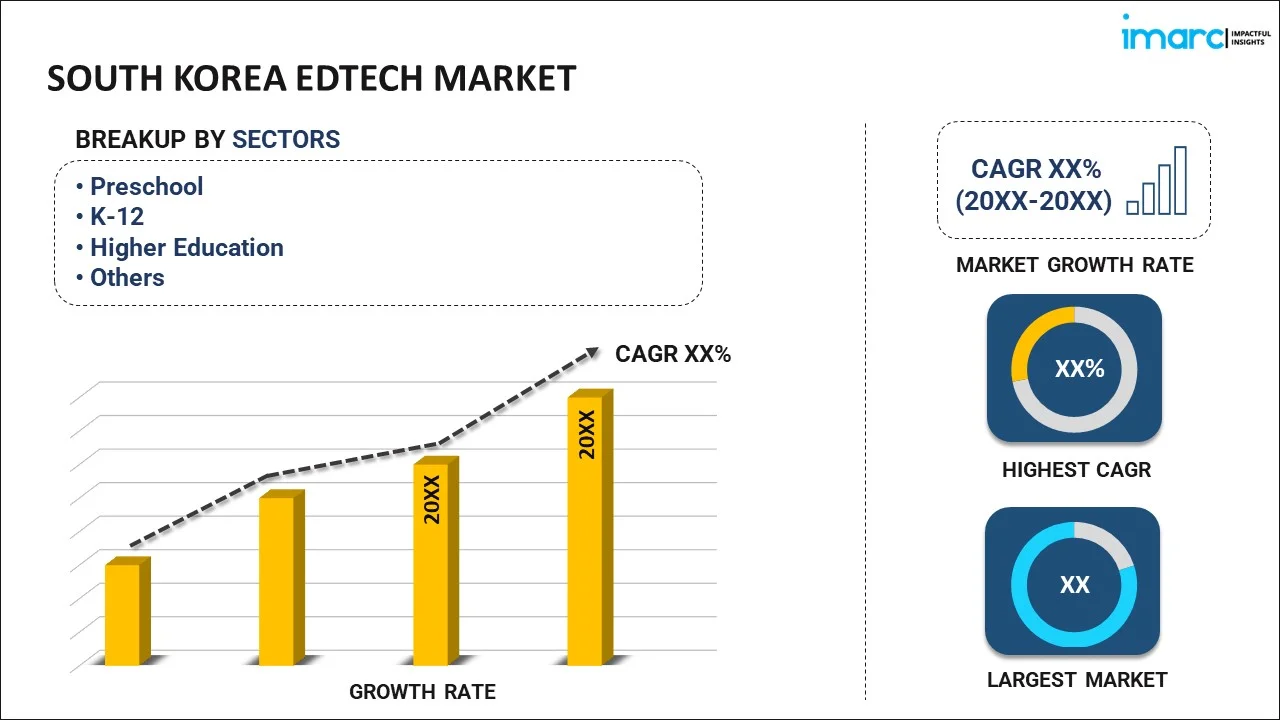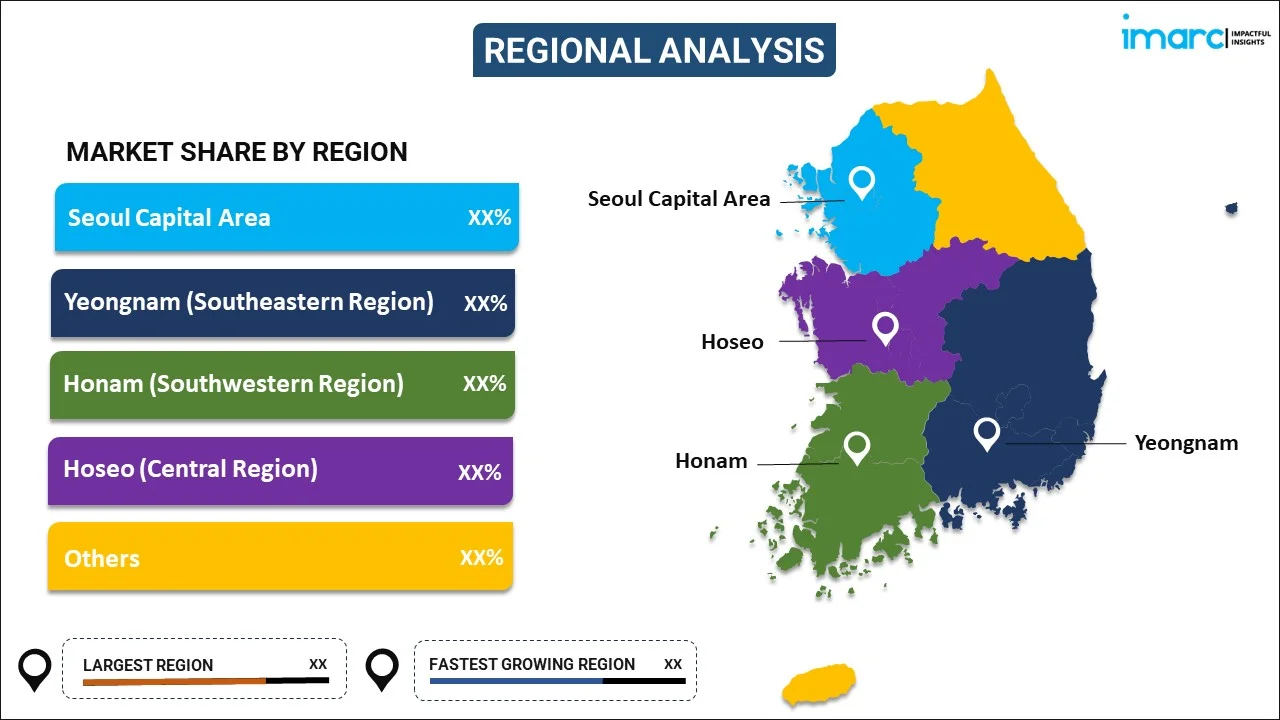
South Korea Edtech Market Report by Sector (Preschool, K-12, Higher Education, and Others), Type (Hardware, Software, Content), Deployment Mode (Cloud-based, On-premises), End User (Individual Learners, Institutes, Enterprises), and Region 2025-2033
Market Overview:
South Korea edtech market size reached USD 4.75 Billion in 2024. Looking forward, IMARC Group expects the market to reach USD 9.98 Billion by 2033, exhibiting a growth rate (CAGR) of 7.70% during 2025-2033. The growing popularity of platforms, which provide flexibility in scheduling and accessing learning materials, increasing integration of artificial intelligence (AI) and machine learning (ML) technologies, and rising integration of data analytics represent some of the key factors driving the market.
|
Report Attribute
|
Key Statistics
|
|---|---|
|
Base Year
|
2024 |
|
Forecast Years
|
2025-2033
|
|
Historical Years
|
2019-2024
|
| Market Size in 2024 | USD 4.75 Billion |
| Market Forecast in 2033 | USD 9.98 Billion |
| Market Growth Rate (2025-2033) | 7.70% |
Edtech refers to the integration of technology into educational practices to enhance learning and teaching processes. It comprises immersive technologies, which enhance learning experiences through simulated environments and interactive content. It includes devices like computers, tablets, interactive whiteboards, and virtual reality equipment. It is integrated with educational software, which ranges from learning management systems to interactive simulations and virtual labs. It has various game elements to make learning engaging and enjoyable. It goes beyond traditional classroom settings, leveraging digital platforms, software, and hardware to enhance educational processes. It facilitates content delivery, assessments, and communication between educators and students. Edtech utilizes data analytics to track and assess student performance, enabling data-driven decision-making. It enhances communication between teachers, students, and parents through tools like emails, messaging apps, and video conferencing. It equips students with digital literacy skills essential for success in the modern workforce. Edtech allows students to progress at their own pace, addressing individual strengths and weaknesses. It reduces the need for physical materials, making education more cost-effective in the long run.
South Korea Edtech Market Trends:
At present, the increasing popularity of the edtech platform, which provides flexibility in scheduling and accessing learning materials and accommodating various learning styles, represents one of the vital factors impelling the growth of the market in South Korea. Besides this, the rising integration of artificial intelligence (AI) and machine learning (ML) technologies is contributing to the market growth. These technologies empower educational platforms with adaptive learning capabilities, enabling personalized learning experiences for students. AI-driven algorithms also analyze individual learning patterns and preferences, tailoring content and assessments to suit the unique needs of students. Moreover, AI and ML play a crucial role in automating administrative tasks, allowing educators to focus more on teaching and mentoring. In addition, Edtech platforms are incorporating gamified elements, such as badges, points, and interactive challenges, to motivate students and enhance their retention of educational content. Apart from this, the increasing demand for skill-based and vocational training programs is compelling edtech companies to offer a diverse range of courses and programs designed to equip learners with relevant, industry-specific skills. Additionally, individuals are recognizing the need to improve their skills to stay competitive and acquire jobs easily. Edtech platforms that provide a variety of courses, certifications, and micro-credentials are catering to this demand for continuous learning. Students are also focusing on adopting home learning models, which allow them to study from the comfort of their houses without traveling long distances. Furthermore, the rising integration of data analytics in edtech platforms to enable real-time assessment and feedback on student performance is bolstering the market growth in the country.
South Korea Edtech Market Segmentation:
IMARC Group provides an analysis of the key trends in each segment of the market, along with forecasts at the country levels for 2025-2033. Our report has categorized the market based on sector, type, deployment mode, and end user.
Sector Insights:

- Preschool
- K-12
- Higher Education
- Others
The report has provided a detailed breakup and analysis of the market based on the sector. this includes preschool, k-12, higher education, and others.
Type Insights:
- Hardware
- Software
- Content
A detailed breakup and analysis of the market based on the type have also been provided in the report. This includes hardware, software, and content.
Deployment Mode Insights:
- Cloud-based
- On-premises
The report has provided a detailed breakup and analysis of the market based on the deployment mode. This includes cloud-based and on-premises.
End User Insights:
- Individual Learners
- Institutes
- Enterprises
A detailed breakup and analysis of the market based on the end user have also been provided in the report. This includes individual learners, institutes, and enterprises.
Regional Insights:

- Seoul Capital Area
- Yeongnam (Southeastern Region)
- Honam (Southwestern Region)
- Hoseo (Central Region)
- Others
The report has also provided a comprehensive analysis of all the major regional markets, which include Seoul Capital Area, Yeongnam (Southeastern Region), Honam (Southwestern Region), Hoseo (Central Region), and others.
Competitive Landscape:
The market research report has also provided a comprehensive analysis of the competitive landscape in the market. Competitive analysis such as market structure, key player positioning, top winning strategies, competitive dashboard, and company evaluation quadrant has been covered in the report. Also, detailed profiles of all major companies have been provided.
South Korea Edtech Market Report Coverage:
| Report Features | Details |
|---|---|
| Base Year of the Analysis | 2024 |
| Historical Period | 2019-2024 |
| Forecast Period | 2025-2033 |
| Units | Billion USD |
| Scope of the Report | Exploration of Historical Trends and Market Outlook, Industry Catalysts and Challenges, Segment-Wise Historical and Future Market Assessment:
|
| Sectors Covered | Preschool, K-12, Higher Education, Others |
| Types Covered | Hardware, Software, Content |
| Deployment Modes Covered | Cloud-based, On-premises |
| End Users Covered | Individual Learners, Institutes, Enterprises |
| Regions Covered | Seoul Capital Area, Yeongnam (Southeastern Region), Honam (Southwestern Region), Hoseo (Central Region), Others |
| Customization Scope | 10% Free Customization |
| Post-Sale Analyst Support | 10-12 Weeks |
| Delivery Format | PDF and Excel through Email (We can also provide the editable version of the report in PPT/Word format on special request) |
Key Questions Answered in This Report:
- How has the South Korea edtech market performed so far and how will it perform in the coming years?
- What is the breakup of the South Korea edtech market on the basis of sector?
- What is the breakup of the South Korea edtech market on the basis of type?
- What is the breakup of the South Korea edtech market on the basis of deployment mode?
- What is the breakup of the South Korea edtech market on the basis of end user?
- What are the various stages in the value chain of the South Korea edtech market?
- What are the key driving factors and challenges in the South Korea edtech?
- What is the structure of the South Korea edtech market and who are the key players?
- What is the degree of competition in the South Korea edtech market?
Key Benefits for Stakeholders:
- IMARC’s industry report offers a comprehensive quantitative analysis of various market segments, historical and current market trends, market forecasts, and dynamics of the South Korea edtech market from 2019-2033.
- The research report provides the latest information on the market drivers, challenges, and opportunities in the South Korea edtech market.
- Porter's five forces analysis assist stakeholders in assessing the impact of new entrants, competitive rivalry, supplier power, buyer power, and the threat of substitution. It helps stakeholders to analyze the level of competition within the South Korea edtech industry and its attractiveness.
- Competitive landscape allows stakeholders to understand their competitive environment and provides an insight into the current positions of key players in the market.
Need more help?
- Speak to our experienced analysts for insights on the current market scenarios.
- Include additional segments and countries to customize the report as per your requirement.
- Gain an unparalleled competitive advantage in your domain by understanding how to utilize the report and positively impacting your operations and revenue.
- For further assistance, please connect with our analysts.
 Request Customization
Request Customization
 Speak to an Analyst
Speak to an Analyst
 Request Brochure
Request Brochure
 Inquire Before Buying
Inquire Before Buying




.webp)




.webp)












